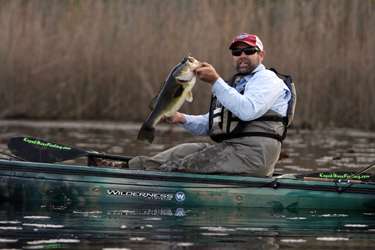
Changing conditions pose the most difficult obstacle for most anglers to overcome. Weather patterns, seasonal transitions, angler pressure, recreational watercraft, fluctuating water levels and other factors change established patterns. Kayak anglers can’t fire up the motor and run to the other end of the lake, so proper pre-trip planning should account for as many variables as possible.
Patterns can be developed over time, but how do you go about shortening the learning curve? Last week, I talked about my personal challenges and the process for coming full circle. This is an ongoing process and something that you can use to improve. Use technology while avoiding becoming dependant.
A solid fishing education is the foundation for your ability to acknowledge the right factors at the right time. Become an information sponge. Here are some of the basic considerations that should be made.
What part of the lake should they be in at this time of year? When should they be feeding? What bait will they be targeting? What are the seasonal migration patterns of the bait? What has the weather been doing and what will it be doing? Are there other species present, such as striped bass, which may alter behavioral patterns?
Considering only the current weather or water conditions can be a mistake. Fish will respond to the weather of the day, but they have been positioned by the trend over a period of time. A good baseline provides a starting point, and factoring in environmental effects will help you zero in a little closer. If you have options when deciding your fishing location, I would suggest deciding where to fish last.
I first consider when I plan to fish. This could be based on the best time to fish or the only time available. Solunar data, seasonal patterns, past experience, journals and other factors are used to make this assessment. The process for deciding where to go and how to fish is based on combining the other variables. Doing your homework helps divide the body of water in order to focus on smaller, more manageable areas. I use fishing reports from previous years and look for similar conditions, but I rarely depend on current fishing reports. They tend to be slightly dated.
I often rationalize the best place to fish based on how I want to catch them. When doing so, I am choosing a location that may be less than ideal, but best for that particular presentation. If you chose this approach, adjust your game plan accordingly. There can be a great deal of satisfaction derived from mastering a particular presentation and fishing it effectively, provided you avoid letting it become a crutch.
Wind direction, sun angle, overnight temperatures, water stratification, vegetation decomposition, run off and other factors are often overlooked. Paying attention to these details can be the difference between failure and success.
Situational awareness starts with the previously mentioned factors, but it doesn’t end there. The second part of the equation comes from observations made on the water. I routinely spend 10, 20, 30 or more minutes just sitting quietly in a new area. I scan the water continuously for any sign, listen intently for any indication and avoid the tendency to immediately pursue the first opportunity. Observe the body language and response from the fish. Preconceived notions are great, but be open to change if you don’t find what you expect.
Take these variables into account and plan a more successful outing. Next week we’ll discuss the considerations and advantages for standing to fish from the kayak.
Editor’s Note: Chad Hoover is originally from Louisiana and is currently on active duty in the U.S. Navy, stationed in Norfolk, Va. He is the owner of www.KayakBassFishing.com and author of Kayak Bass Fishing ($24.95 on his site). He also serves as the kayak Pro Staff Director for Wilderness Systems kayaks, Torqeedo motors and Secret Weapon Lures.




